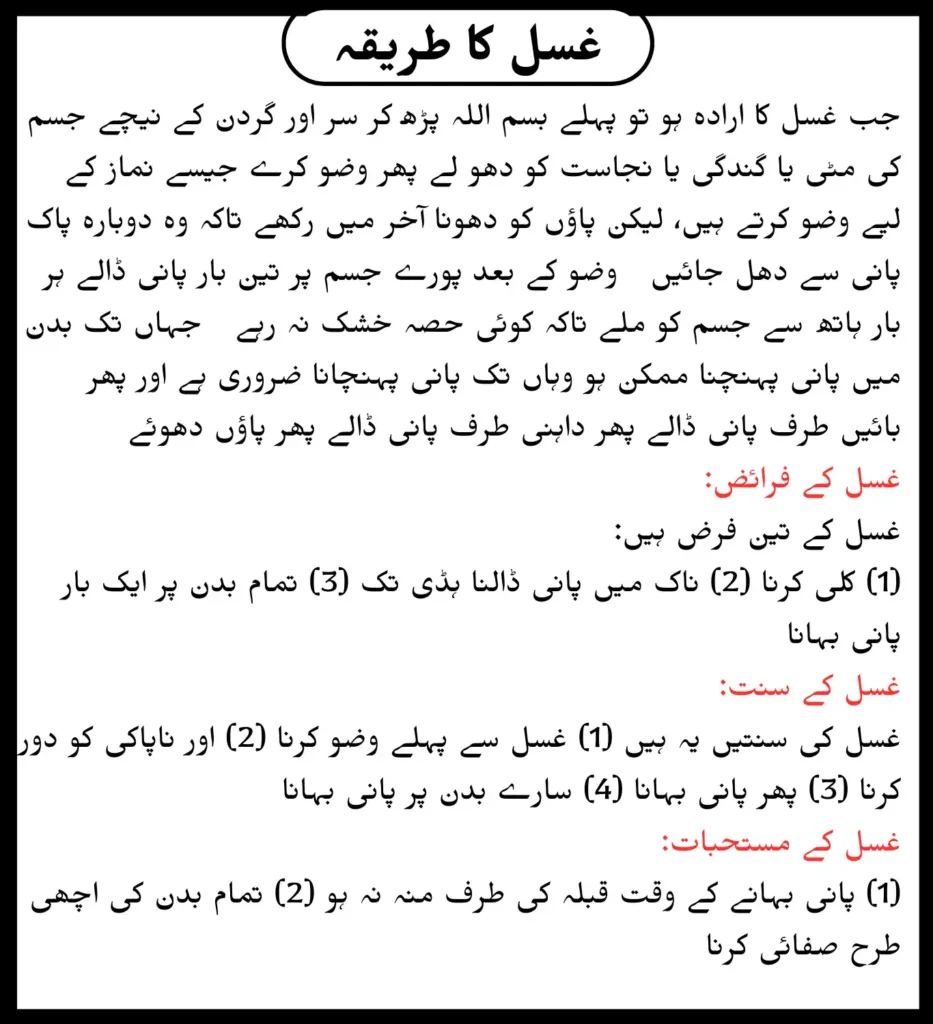Ghusl (غسل) is an essential Islamic purification ritual that every Muslim must perform in specific circumstances. It is not just about physical cleanliness but also a spiritual act that prepares a Muslim to engage in religious activities like Salah (نماز) and recitation of the Quran. The correct method of performing Ghusl ensures that one is spiritually clean and ready to worship Allah (ﷻ). This guide will walk you through the steps of performing Ghusl according to the Sunnah and will highlight the obligations (فَرَائِض) associated with it.
Steps for Performing Ghusal ka Tarika (غسل کرنے کا طریقہ)
- Niyyah (نیت) – Intention: Start with the intention of purifying yourself for the sake of Allah (ﷻ). This is a mental intention and does not need to be verbalized.
- Bismillah (بسم اللہ) – Begin with the Name of Allah: Recite “Bismillah” before starting the Ghusl to seek blessings and protection.
- Wudu (وضو) – Ablution: Perform Wudu as you would before Salah. This includes washing your hands, rinsing your mouth, washing your face, arms, wiping your head, and washing your feet. However, if you are taking a complete bath, you can delay washing your feet until the end.
- Main Wash (پانی بہانا): After Wudu, pour water over your head three times, ensuring it reaches the roots of your hair. Then, pour water over your entire body, starting from the right side and then the left. Make sure water reaches every part of your body, including under your arms and between your toes.
- Final Rinse (دوبارہ پانی ڈالنا): Wash your entire body again to ensure no area is left dry.

Ghusl Ke Faraiz (غسل کے فرائض)
Ghusl has three essential obligations, and without fulfilling these, the Ghusl is not valid:
- Gargling (کلی کرنا): Ensuring water reaches the entire mouth.
- Nose Cleaning (ناک میں پانی ڈالنا): Ensuring water reaches the soft bone of the nose.
- Washing the Entire Body (تمام بدن پر پانی بہانا): Ensuring that no part of the body is left dry, even the smallest spot.
Ghusl Ke Sunnat (غسل کے سنت)
Following the Sunnah while performing Ghusl ensures that you are not only physically clean but also following the practices of Prophet Muhammad (ﷺ):
- Wudu Before Ghusl (غسل سے پہلے وضو کرنا): Perform Wudu first, as it is the practice of the Prophet (ﷺ).
- Starting with the Right Side (دایاں طرف پہلے دھونا): Begin washing from the right side of your body.
- Pouring Water Three Times (تین بار پانی ڈالنا): Pour water three times over the head and body.
| Dua for New Clothes: A Prayer |
| Dua e Jameela: A Powerful Supplication |
| Wazu Ka Tarika: A Step-by-Step Guide |
| Pani Peene Ki Dua | Dua for Drinking Water |
Ghusl Ke Mustahabbat (غسل کے مستحبات)
These recommended acts (Mustahabbat) enhance the purity of Ghusl:
- Face Qiblah (قبلہ کی طرف منہ کرنا): If possible, face the Qiblah while performing Ghusl.
- Avoiding Wasting Water (پانی کا ضیاع نہ کرنا): Use water efficiently and avoid wastage.
- Cleaning the Whole Body Properly (بدن کی اچھی طرح صفائی کرنا): Ensure thorough cleaning, especially areas where sweat or dirt may accumulate.
Conclusion
Understanding the proper method of performing ghusal ka tarika is essential for every Muslim. It is not just a physical act but a spiritual one that renews your connection with Allah (ﷻ). By following the obligations, Sunnah, and Mustahabb of Ghusl, you ensure that your purification is complete and valid. Remember, Ghusl is a simple yet profound act that purifies both the body and soul.
FAQs:
The obligatory steps in Ghusl are gargling, cleaning the nose, and washing the entire body.
Yes, Wudu is included within Ghusl but performing it separately before the main wash is Sunnah and recommended.
Ghusl purifies a person physically and spiritually, making them eligible for Salah and other religious activities.




